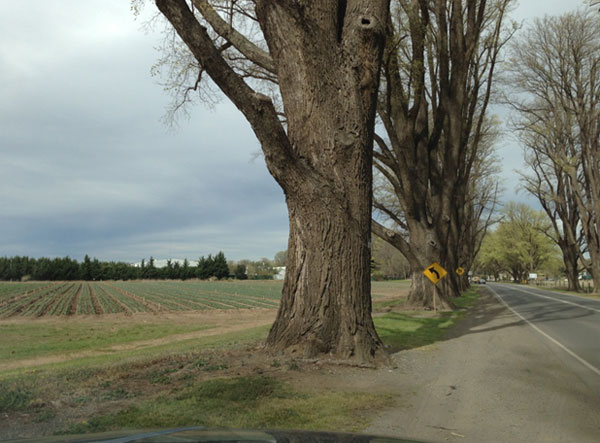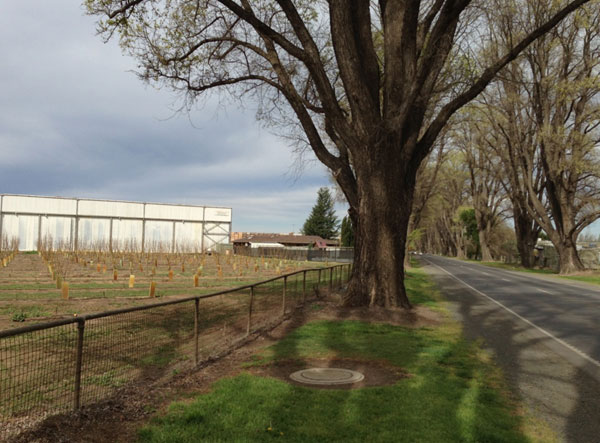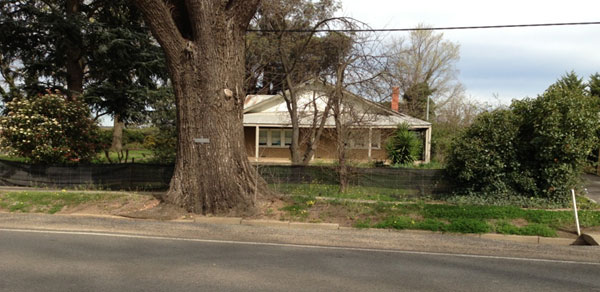*A large elm with a trunk diameter of 100cm requires 56 grams of active constituent when soil injected at the label rate for elm leaf beetle. FACT.
*The highest agricultural label rate is in sugarcane, its applied to the soil at 500 grams of active constituent to 1 hectare (10,000 square meters) FACT.
*A contractor in order to save time will generally soil inject within a 3 meter radius of the main trunk in a street tree situation.
This is equivalent to 28.27 square meters; a hypothetical figure BUT GENERALLY TRUE.
*Contractors need to inject within this zone in most cases as roads, gutters and private property are a limiting factor.
A hypothetical statement BUT GENERALLY TRUE.
*Example 100cm elm tree needs 56 grams of active, divide by 28.27 square meters of rootzone that is soil injected
This equals 1.98 grams of active constituent per meter, multiply this by 10,000 square meters (1 Hectare)
This equals 19.8 kilograms applied to one hectare.
Large elms in an avenue situation fall within this range; this is a hypothetical figure BUT GENERALLY TRUE.
*Example: Divide 19.8 kilograms by 504 grams the maximum agricultural label rate in sugar cane.
This equates to 39.28 times the maximum agricultural label rate, this is a hypothetical figure BUT GENERALLY TRUE.
*If a farmer soil injected nine 100cm diameter elms within one hectare paddock that would equal the maximum agricultural hectare rate at 504 grams of active constituent. FACT
*Imidacloprid will leach through the soil profile at non defined rate according to rainfall and soil type. FACT.
*Soil injected imidacloprid residues have been found to contaminated groundwater FACT.
*Soil injection and ground applications using imidacloprid is restricted pending a ban in some states in the USA and banned in most of the European Union FACT.
*All flowering plants and grasses around a soil injected elm are exposed to imidacloprid at a rate many times the agricultural label maximum.
This is a hypothetical STATEMENT BUT GENERALLY TRUE.
*Bees ingest nectar and pollen from these flowers at sub lethal or lethal rates and die FACT.
*Bees ingest neonicotinoids via “Guttation” (dew) on grasses and small flowering plants at sub lethal or lethal rates and die FACT.
*Elm trees are mostly wind pollinated and flower in late winter and spring, bee activity is lower in cool areas but higher in warmer areas FACT.
*Bees are attracted to pollen in late winter and spring, pollen provides an essential protein boost when its really needed FACT.
*This presents a high risk for foraging bees on trees that have been treated with imidacloprid FACT.
*Newer tree injectables such as Ema-ject® are safe, residues were not detected in elm pollen and samaras (elm seeds). FACT.
*Emamectin benzoate is the active ingredient in Ema-ject®, it is an entirely different class of chemistry to imidacloprid. FACT.
*The agricultural rate in a temperate climatic situation for Citrus is 3.1 grams of active ingredient per tree, With Holding Period (WHP) 20 weeks, this means you can’t eat or sell the fruit FACT.
*The maximum butt drenching rate in Apples is 612.5 milligrams of active ingredient per tree, this can only be applied once every Two Years, FACT.
*Maximum WHP are set by the APVMA to ensure human health, our exports and the environment are not compromised. FACT.
*Meat & Livestock Australia require farmers to sign a declaration prior to selling livestock on all pesticides used in areas grazed. FACT
*If residues are detected that exceed the Maximum Residue Limit (MRL) penalties are incurred FACT.

In this situation potential for off target contamination of soil and tree crops into private property is very high, if higher residues are detected there is the possibility of a legal problem with implications directed against the contractor or council or both. Further and potential pending problems with insurance and its underwriters may well be in the pipeline, as a cascading reaction to the European Unions suspension of three neonicotinoids.
Furthermore the European Unions suspension status will be reviewed sometime in late 2014/15, it is expected that the outcome will have a domino effect on none EU countries like the USA, Canada and Australia to amend labels in regards to applications and the dose rates used.

Elm trees in this avenue have been soil injected in the past were last soil injected in the spring of 2013. This is part of the council’s ongoing elm leaf beetle treatment program. Note that this complies with the label and is legal, label rates are approved by the APVMA.

The potential for off target uptake via flowering weeds and woody perennials is very high, note that both Viburnum and the Oxalis on the nature strip are in flower.
Risk Mitigation
There are safer alternatives that are already in use, tree injection or micro injection is the responsible option that many tree managers are now endorsing, it fits smoothly within any environmental risk matrix when compared to soil injection.
Basic Facts
Tree injection with imidacloprid at the maximum label rate in elms uses 5.6 times less chemical than soil injection. At the minimum effective label rate it uses 9.3 times less chemical than soil injection.
Tree injection internalises the chemical within the tree, this reduces the environmental and legal risks substantially.
Elm are wind pollinated and flower in late winter when bee activity is low.
For further information:
- Neonicotinoids, bee disorders and the sustainability of pollinator Services. Refer to Conclusions
https://www.sciencedirect.com/science/article/pii/S1877343513000493
- Translocation of Neonicotinoid Insecticides From Coated Seeds to Seedling Guttation Drops: A Novel Way of Intoxication for Bees.
http://sverigesradio.se/diverse/appdata/isidor/files/83/7239.pdf
- Conclusion on the peer review of the pesticide risk assessment for bees for the active substance imidacloprid
http://www.efsa.europa.eu/en/efsajournal/pub/3068.htm?utm_source=homepage&utm_medium=infocus&utm_campaign=beehealth






